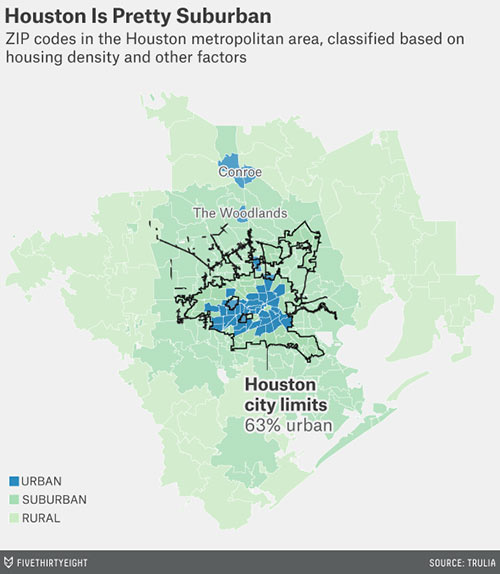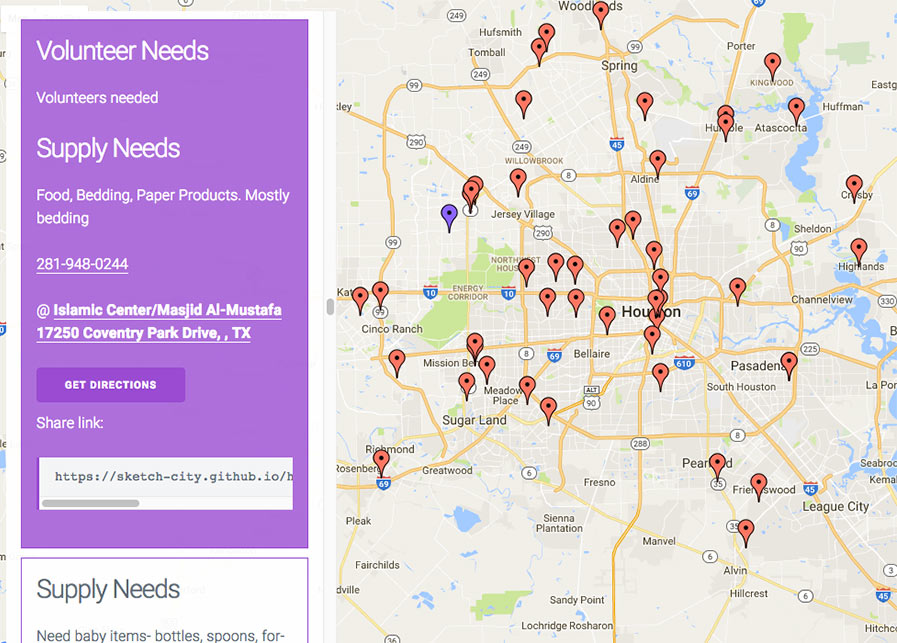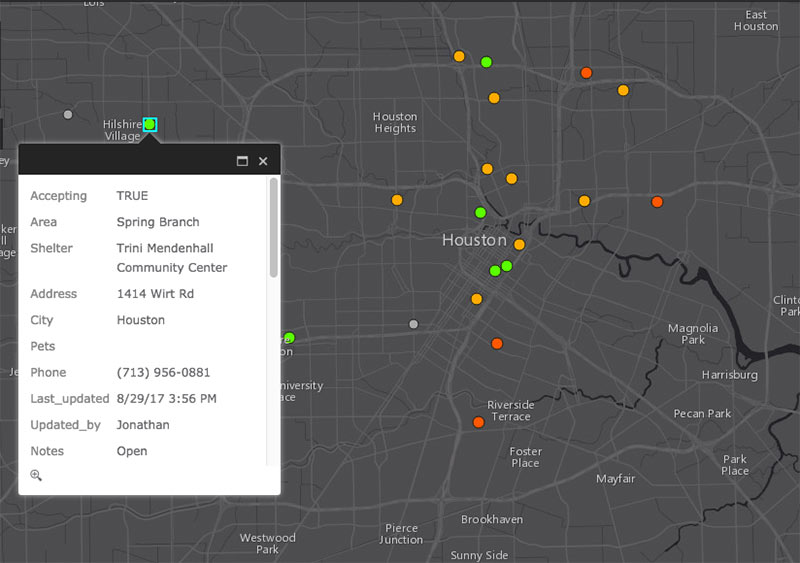HOUSTONIANS THINK HOUSTON IS 63 PERCENT URBAN, KINDA  In a guest post for ESPN’s FiveThirtyEight, Trulia’s chief economist trots out a bunch of maps and charts that purport to show that Houston, unlike the other 5 most populous U.S. cities, is actually only 63 percent urban. But among the lower-downs on that list, Houston isn’t the big suburban metropolis standout. Phoenix and San Antonio rate half of Houston’s urbanity, and even San Diego comes in at a sprawling 49 percent. Of course, there’s the small question of how anyone determines whether a place is urban. Trulia went with the old “know it when I see it” rule, rating a Zip Code urban if its residents called it urban, suburban if they called it so, and rural otherwise. But with only 2,008 responses to their online survey, the company had to resort to other measures to fill out its maps for Houston (above) and several other cities, including figures for the density of households within a particular Zip Code. [FiveThirtyEight] Map: FiveThirtyEight
In a guest post for ESPN’s FiveThirtyEight, Trulia’s chief economist trots out a bunch of maps and charts that purport to show that Houston, unlike the other 5 most populous U.S. cities, is actually only 63 percent urban. But among the lower-downs on that list, Houston isn’t the big suburban metropolis standout. Phoenix and San Antonio rate half of Houston’s urbanity, and even San Diego comes in at a sprawling 49 percent. Of course, there’s the small question of how anyone determines whether a place is urban. Trulia went with the old “know it when I see it” rule, rating a Zip Code urban if its residents called it urban, suburban if they called it so, and rural otherwise. But with only 2,008 responses to their online survey, the company had to resort to other measures to fill out its maps for Houston (above) and several other cities, including figures for the density of households within a particular Zip Code. [FiveThirtyEight] Map: FiveThirtyEight





That map shows 77096 is “urban”. Take a Google Earth gander at it and you’ll see it’s almost entirely single family homes on big lots. Lots of trees, lots of swimming pools. Who thinks that’s “urban”?
Of course this study seems incredibly inaccurate to anyone that’s spent a good deal of time in other “more urban” places, but, this shouldn’t be surprising in any way.
77003 is listed as suburban? Hmmm.
We are so connected by freeways, that’s our urban, and the kind of life determines urban, too. 77096 is urban. Urban that was setup and that still got built before and after cars is the old urban.
I grew up in “San Diego” and not many people I know who still live in San Diego live in “San Diego”. Most live in Vista, Carlsbad, San Marcos, Escondido (where I grew up), Poway, El Cajon, etc. etc. So I can see, at least by that metric, how SD can be very un-urban.
Wait, is “urban” just a racial code word in this study? Sort of like it is in the “urban contemporary” radio format?
I live in 77096 and its defintely urban….
Without a standard and widely accepted definition of urban and suburban how on earth can anyone determine what if where they live is urban or suburban? Is it density/people per square mile or households per square mile? My perception is that Houston is more of a suburban city than urban city but what the F do I know. My frame of reference is NYC and Boston.
The only urban part of Houston is about 100 square blocks of downtown. The rest of it is suburban.
Perhaps urban is defined by the number of mattress stores?
So according to this, the Memorial Villages are “urban” and the Texas Medical Center and Eado are “suburban”?
@C, @Monica, anyone else who thinks 77096 is urban:
.
What do you see in 77096 that makes you categorize it as “urban”? I live there, too, and I’m not seeing it. What am I ignoring?
Urbanity is determined by the presence or absence of a Börk.
The sample size of this study is way too small to be able to reliably draw a map of every major city, so don’t pay close attention to individual zip codes. That’s not going to be very useful. For that matter, they should’ve ignored city limits because those are arbitrary political boundaries. That’s a validity problem.
There are already estimates available for population and employment in each zip code, so they could have simply done a density map and also presented a much finer level of detail. Instead they’re trying to measure a word that has a definition that can’t be agreed upon, and that is interesting because they’re gauging perceptions rather than objective facts. Imagine if they had asked people whether their neighbors are mostly “middle-class” and contrasted responses with existing demographic and economic data for each neighborhood. Its easy to imagine the patterns of bias that people would reveal from their feedback.
I live in 77096 and as much as I’d like it to be urban, I have to admit it feels very suburban, and walks like a suburb. If you walk the streets, you are walking among single-family units; you generally have to drive to get to stores/restaurants/entertainment. It’s a great place to live, but it isn’t urban. In my mind, urban environments provide amenities that can be easily reached without a car.
The kicker though? Population density in 77096 is 5,447/square mile (2010 Census Data) compared to distinctly more urban areas such as New York (27,016/sq mile), San Francisco (17,246), Boston (13,321), Chicago (11,868), Philadelphia (11,233), or Miami (10,160). 77096 is more dense than Houston as a whole (3,515), but then again so are 88 other cities in the US…
So Conroe is “urban” but midtown isnt? I’m sensing a flawed methodology.
I think 77096 is urban, while even though you have to drive wherever you want to go, you are, within a few minutes, near activity, ie meyerland plaza, bellaire blvd–by west u. I also consider things as being urban as how quickly the skyline of the city comes into view, it comes pretty quickly into view from meyerland. I also think things are urban if the community is very diverse (btw I grew up in the suburbs, northshore, of course, back in the 80’s so its different now), here in meyerland you can go to the run down heb on chimney rock and hear english, spanish, arabic, hebrew, chinese, in one stop. Also, within a few minutes drive here in 77096, you can go to a ton of diverse restaurants as well. I think diversity is a huge element of whether something is urban.